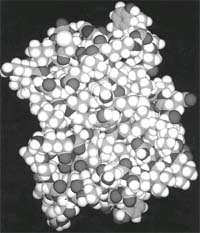Left or right?
 one of the intriguing mysteries of molecular biology is the reason why living organisms choose a particular handedness of molecules rather than their mirror image counterparts. For instance, crucial molecules like amino acids and sugars come in both right-handed and left-handed versions, but for some reason, living organisms only use left-handed amino acids and right-handed sugars. The puzzle is to explain why living organisms in their evolution make such a choice. Now scientists in France have a new theory that claims that magnetic fields play a crucial role in determining the handedness of molecules ( Nature , Vol 405, p932-935).
one of the intriguing mysteries of molecular biology is the reason why living organisms choose a particular handedness of molecules rather than their mirror image counterparts. For instance, crucial molecules like amino acids and sugars come in both right-handed and left-handed versions, but for some reason, living organisms only use left-handed amino acids and right-handed sugars. The puzzle is to explain why living organisms in their evolution make such a choice. Now scientists in France have a new theory that claims that magnetic fields play a crucial role in determining the handedness of molecules ( Nature , Vol 405, p932-935).
In 1848, Louis Pasteur discovered that tartaric acid crystals came in two varieties that are mirror images. The difference was that these two varieties rotate light in different ways. Scientists since Pasteur have tried, and failed, to use magnetic fields to influence whether right-handed or left-handed molecules are produced in a chemical reaction, a process called enantioselection. In the 1980s, however, scientists realised those mirror-image molecules, when placed in a magnetic field, absorb light at slightly different rates, a property called magnetic dichroism.
Now G Rikken and E Raupach of the cnrs 's High Magnetic Field Laboratory in Grenoble, France, show that a magnetic field can interact with light to induce an imbalance in the handedness of molecules produced in a light-driven chemical reaction. The team used an unstable chromium complex compound that breaks down even faster if it absorbs a particle of light. They put a small amount of the molecules in a powerful magnetic field and shined a laser through the solution. One of the molecules absorbed light more readily than its mirror image and was more likely to break down with the result that the solution quickly became enriched in the less absorbing molecule.
For life on Earth, such a process could have a profound effect. If on the surface of a meteorite, such a process was going on in sunlight (in the presence of the magnetic field of a nearby star) then, the organic molecules produced would have a definite handedness. Another scenario is that such a process could have taken place with the Earth's magnetic field and normal sunlight on the surface of the Earth at the time when the original molecules that are the building blocks of life were forming in the primeval soup. Though still a laboratory curiosity, the experiment at Grenoble could have a profound effect on our understanding of life.
Related Content
- Judgment of the National Green Tribunal regarding concretization of open spaces and green belts in Punjab, 30/01/2024
- Ensuring safe water and sanitation for all: a solution through science, technology and innovation
- What Happened in CoP26
- Between hunger and the virus: the impact of the Covid-19 pandemic on people living in poverty in Lagos, Nigeria
- Financing China’s sustainable urban transformation
- Joint Committee report on whether Vaiyavur and Nathapettai should be converted into a bird sanctuary, Kancheepuram district, Tamil Nadu, 10/02/2021
